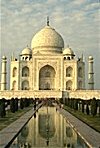|

INDIAN CIVILIZATION
The earliest Indian art emerged from the valley of the Indus River
during the second half of the 3d millennium BC The best-known sites are Harappa, destroyed in the 19th cent., and Mohenjo-Daro;
these are among the earliest examples of civic planning. Houses, markets, storage facilities, offices, and public baths were
arranged in a gridlike scheme. There was also a highly developed drainage system.
The Indus civilization
produced many statuettes made of steatite and limestone. Some statuettes resemble the hieratic style of contemporary Mesopotamia,
while others are done in the smooth, sinuous style that is the prototype of later Indian sculpture, in which the plastic modeling
reveals the animating breath of life (prana). Also found in this region are square steatite seals adorned with a range of
animals, including naturalistically rendered bulls; ceramic storage jars with simple, stylized designs; toys with wheels;
and figurines, which may be mother goddesses. Bronze weapons, tools, and sculptures indicate a sophistication in craftsmanship
rather than a major aesthetic development.

Although a great deal of Indian secular art was produced, it was
essentially made of perishable material and has not survived. What has survived in the medium of stone is religious art. In
both Buddhist and Hindu art, symbolism in gesture, posture, and attribute contains many levels of meaning. In images of the
Buddha, different hand positions (mudras) signify religious states, such as the Enlightenment (Nirvana), Meditation, and Preaching.
In Hindu sculpture, deities (see Vishnu , Krishna , and Shiva ) are frequently represented with many hands to indicate their power
to perform multiple deeds at the same time, and the hands each carry their characteristic attributes. With the exception of
Mughal art and architecture , which demands separate treatment, the major trends in Indian art-Hindu,
Buddhist, and Jain-are discussed within this article.
click here for a website to Indian Civilization
| INDIAN
CIVILIZATION, AN INDEGENOUS DEVELOPMENT |
|
|
| Under the idea
that all civilization came from the Middle East, it was assumed that Harappan culture derived its impetus from the Middle
East, probably Sumeria. Recent French excavations have shown that all the antecedents of the Indus culture can found within
the Indian subcontinent going back before 6500 BC as revealed by the Mehrgarh site near the Bolan Pass in Pakistan.
Mehrgarh is the largest village/town culture of its
period anywhere in the world and develops into the Indus culture by a series of stages, showing the evolution of agriculture
and arts and crafts typical of Harappa.
|
QUESTIONS ABOUT THE INDIAN CIVILIZATION
1. Who are the ancestors of Asian Indian people? What are the characteristics of their cities?
2. What is the religion of these people? What are their beliefs?
3. Why is symbolism important in their art? give examples.
4. What is mahabharata? What is it all about?
5. What is the caste system? How are the people classified?
6. What is the Taj Mahal? What is its story?
7. What ideas do you have of Asian Indians, the people, the culture, and the society?
8. How did the western civilization influence the Indians?
|

